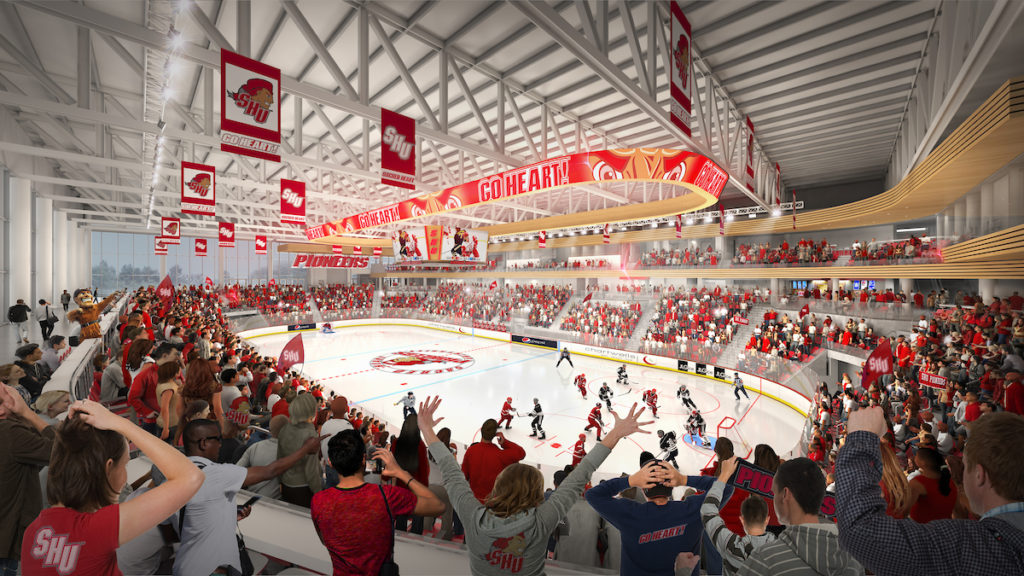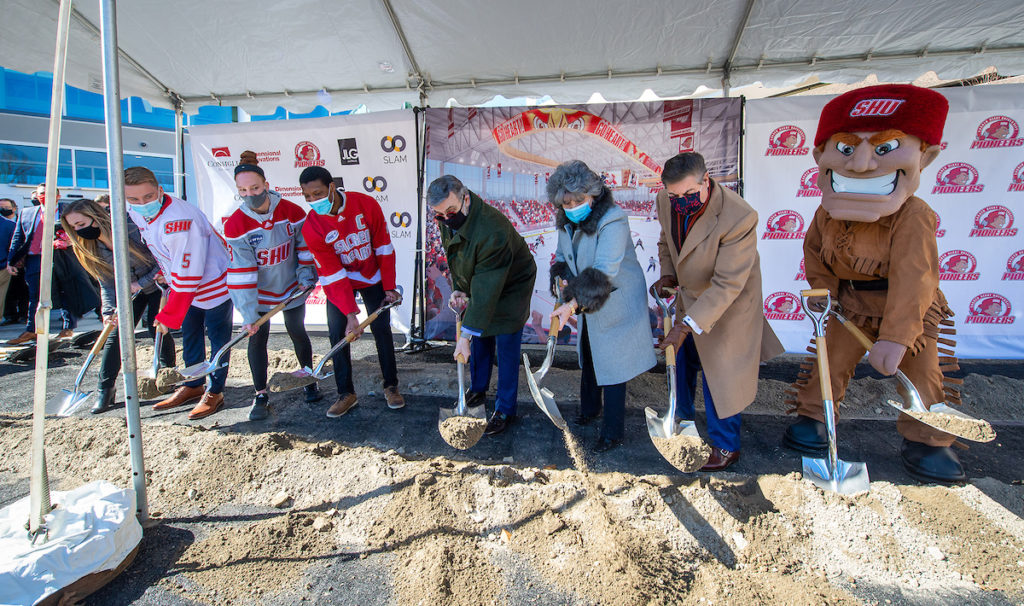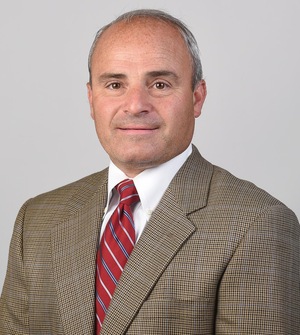
This past weekend fulfilled the promise placed when college hockey started its 2020-21 season at Thanksgiving.
Teams threw laundry on the ice and hoisted trophies in celebrations two years in the making. They fulfilled dreams by reaching the end points hatched when the sport pushed its season off the starting grid to navigate a bumpy road through a global pandemic.
These final days helped emphasize every league, which to Atlantic Hockey meant a well-publicized collision with its trademark parity. Western underdogs advanced to face eastern megaliths in the first cross-geographic meeting between the two pods, and the newest powers rose through a league defined by programs once left behind in the more recent college hockey’s arms race.
The pomp of the games at the MassMutual Center were not, however, the biggest celebration in the conference last week.
Two hours south of the championship weekend hosted by American International, Sacred Heart University was putting its first shovels into the ground for its biggest achievement as a Division I hockey program. It planted a flag, permanently, in the college hockey landscape and broke ground on the new hockey palace at the Martire Family Arena.
“The dream is to compete on a regular basis at a national level,” said Jim Barquinero, senior VP of enrollment, student affairs and athletics for the university. “You can make the tournament and in hockey, gain that first-round game. We want to get in on that thing. We won the Connecticut Ice last year and beat UConn, which is a Hockey East school. Then we beat Quinnipiac, which is an excellent, excellent program. I think we all looked at each other and saw we were in the thick of planning for the arena. It was quiet, but we were doing that, and we looked and saw that we could do it playing in a relatively empty arena. Imagine what we’ll be able to do (in a new building).”
The emotional moment resonated with anyone who recalled Sacred Heart’s earliest days. Investing substantially in hockey immediately moved the Pioneers into college hockey’s upper echelon and established a new tradition among blue bloods in a region defined by a neighboring state. The money, the celebration and the ceremony all were part of a massive thunderclap, but the new masthead meant more to a greater metropolitan area now at the forefront of the sport’s trailblazing future.
A school, a state, a story
It doesn’t take very long to find Sacred Heart University.
Located just off the Merritt Parkway, it essentially straddles the line dividing the town of Fairfield and the city of Bridgeport in western Connecticut. Both the main campus and its West Campus counterpart border the highway, which runs horizontally across the state. It’s a quaint location located just in between the trip from Hartford to New York City.
The state’s hockey culture was once defined by the halcyon Hartford Whalers and their signature Brass Bonanza, but a registered membership with USA Hockey bubbles under the surface. The Whalers are long gone to Carolina, but the number of hockey players in the area still rival the NHL markets of the states of New Jersey and Ohio as well as the individualized eastern and western divisions of Pennsylvania, and it ranks second to only Massachusetts among New England states.
Six Connecticut hockey players are now in the NHL, five of which played college hockey. Each of that handful has more than 600 games played at the highest level, with one – Jonathan Quick – earning two Stanley Cup rings and a Conn Smythe Trophy as postseason MVP.
Yet everyone seemingly left the state at some point.
Quick, a Milford resident, backstopped UMass to its first-ever NCAA tournament appearance before winning those championships with the Kings. Cam Atkinson grew up in Greenwich but won a national championship for Boston College in 2010. Hartford native Nick Bonino did the same in 2009 with Boston University with Kevin Shattenkirk, who likewise played in Greenwich at the Brunswick School.
Their success represents Connecticut’s success, but they paper over the more harsh reality from an older time when there was only one “big time” college hockey program. That was Yale, which can date its legacy back to hockey’s earliest era as the only Division I program prior to the late 20th century. The other college teams all competed in the cross-divisions of Division II and III, and none really enjoyed a true home.
“You had a lot of Division III schools,” current Sacred Heart coach CJ Marottolo said. “You had Connecticut College and Trinity from back in the day, and they’re still playing hockey. Then you had other schools like Sacred Heart, UConn, and Quinnipiac, which emerged when the MAAC came into being.”

The MAAC was the Metro Atlantic Athletic Conference and the charter league for college hockey programs that wanted to play Division I but lacked the resources, facilities and tradition of Hockey East and ECAC. It built a league around its traditional footprint in New York State and Connecticut with Canisius, Fairfield and Iona forming a league with other orphaned programs like American International, Holy Cross and Sacred Heart.
It helped the Pioneers get into Division I in one sport as it looked to realign its entire athletics department. The small, Division II school attempted to join the Northeast-8 Conference but was rebuffed for a potential move. It led the university to pencil in a potential move to Division I, which became reality when it reclassified in the late-1990s to the ironically-named Northeast Conference. The NEC didn’t sponsor hockey, so the MAAC was a logical landing spot for SHU. It chartered the conference with those other institutions and remained a piece as Mercyhurst and Bentley joined shortly thereafter.
“When I got here in September of 1989, the then-athletic director and still-legendary basketball coach Dave Bike had just won the national championship in 1986,” said Barquinero. “We had gotten to the minimum of eight that were really functioning for sports, and I added 27 sports in the 1990s. I had a brother that played (football) at Amherst, and I knew a lot of people in both the NESCAC and in the Ivy League. The best academic schools, particularly in the northeast, also had the most teams athletically. So that’s how I looked at it.”
“Connecticut has always been a state with great players,” Marottolo added. “The USA Hockey summer camps in New England were always very well represented in those 14-year old and 15-year old age groups and the 16-year old and 17-year old age groups. They were always very good players here, and that goes back to the beginning of my Yale days. I’m very, very happy to see the Connecticut kids thrive, and now there are more places in Connecticut for them to choose from.”
Because the MAAC schools lacked the overall package of Hockey East and ECAC, the schools committed to building bigger profiles represented potential fillers when college hockey began realigning. When Vermont left ECAC for Hockey East in the mid-2000s, Sacred Heart applied for the now-vacant spot in the more traditional league, but it did so against Quinnipiac. The Hamden-based school was on the verge of opening the now-named People’s United Center and unquestionably possessed a stronger package, and it subsequently moved into ECAC as Princeton’s new travel partner.
It kept the Pioneers in the MAAC as it underwent its own overhaul. Fairfield and Iona dropped hockey in 2003 prior to Quinnipiac’s departure, and Canisius’ status as the lone MAAC-sports member forced a reorganization into Atlantic Hockey. Sacred Heart soldiered forward with the state’s flagship school at UConn, but it was left as the only Connecticut-based entry when the Huskies left for Hockey East after the 2011-2012 season.
Part of the issue was the Pioneers’ facility. They had played at the Milford Ice Pavilion since their first season in 1993, but it was a municipal ice rink on par with AIC’s Olympia Ice Center and Bentley’s John A. Ryan Arena. All were functional and served an adequate purpose for hockey games, but they offered a major barrier to attendance, marquee home games and recruiting. When Quinnipiac left, it had the aforementioned building, and UConn outsourced its games to the XL Center in Hartford while renovating its on-campus Mark E. Freitas Ice Forum. The Pioneers, like the rest of their eastern AHA brethren, couldn’t compete at that level.
“In the early 90s, I was adding a bunch of sports when I got the job here (at Sacred Heart),” Barquinero said. “Football was one of them, as was a bunch of others, but hockey was right at the top of the list. I knew college hockey in New England having gone to St. Anselm’s, and I followed the sport (in the region). So I kind of felt like I knew what I was getting into, even though the facility issue was real.”
Out of the shadow
Through everything, Sacred Heart never really had a problem winning games on the ice. A win over Cornell in 2000 defeated a team bound for its conference championship game that year, and three years later, the Pioneers split with Miami University. The 2004 team advanced to a conference championship, and both the 2005-2006 and 2006-2007 seasons produced 20-win years. In 2008 and 2009, Sacred Heart beat Connecticut in the postseason.
The results were part of a construction project headed by head coach Shaun Hannah. He became the head coach in 1996 and moved Sacred Heart’s team up to the Division I level, and his teams gradually factored into the more consistent MAAC and Atlantic Hockey discussions. He won 191 games and finished no lower than fifth annually with two notable exceptions – his first and last seasons.
Hannah built a winner, but his resignation for personal reasons one month before the start of the 2009-2010 season drew headlines prior to the start of the season. It left a void at the top of the program, one that was filled two weeks before the season by Yale assistant coach CJ Marottolo.
Marottolo had been in New Haven under Tim Taylor and Keith Allain since 1996, and his father, Carl, was a New Haven legend who founded the Yale Youth Hockey program. His family was a deep part of the state’s hockey culture, even though he, like so many others, left the state to play college hockey at Northeastern. Somewhat notably, he actually was part of the last team to win the Beanpot prior to the Huskies’ victory in 2018.
His first year was nothing short of a hair-on-fire magic. Sacred Heart stumbled to a 3-9-2 start but rattled off 10 unbeaten games after defeating Dartmouth just before Christmas. It finished the year with 18 wins in the regular season and advanced to Atlantic Hockey’s championship game before falling just short of its first-ever trip to the national tournament.
“We were starting to get to know each other,” Marottolo. “We were getting to know them as players and as people. There was a game against Army where we played well but didn’t win. We came back in that game but shot ourselves in the foot, but my staff and I watched the third period at the rink in the locker room. Nobody talked, and we just watched it. From that point on, we knew we could be pretty good if we played with discipline. After that, we went on that run, and it rolled off into the playoffs.”
That season blew the cover off the potential for a successful Division I program. The Pioneers watched RIT celebrate a conference championship and witnessed history when the Tigers advanced to the Frozen Four a week later. For a team that went 12-2-2 at home during the season, it was a call to arms for the unbridled potential of what could happen with the right infrastructure.

Marottolo understood that better than anyone, and after a transition period over the next few years, he built Sacred Heart back into an Atlantic Hockey powerhouse. It followed a similar formula to the program’s first years in Division I: a win over preseason No. 1 UMass-Lowell shocked the start of the 2013-2014 season, and Sacred Heart beat Connecticut in the UConn Hockey Classic over the holidays that year. The next year, the Pioneers beat the Huskies on the road with a 7-4 win.
Sacred Heart pushed into eighth place in 2015 and played back-to-back postseason wars against Bentley in 2016 and 2017. It battle-hardened the team before a fourth place finish in 2019, and the 2020 team finished second before the COVID-19 pandemic cancelled the postseason.
“I think everybody wants to leave the program in a better place than when they got there,” Marottolo said. “That was our mindset, and that’s what drove our group every day. There are ups and downs, and high points and fighting through adversity, and that’s their charge. They want to look back and say that their four years are in a better spot.”
The success coincided with unprecedented growth within Atlantic Hockey. AIC won the conference championship with a wire-to-wire performance in 2019, and the Pioneers’ second place finish was behind only the Yellow Jackets. Bentley, which battled SHU in those consecutive playoffs, opened a new building in 2018 as the investment from all three schools paid off in a big way.
That made it somewhat unsurprising when each year’s incoming class seemingly rewrote the program record books. A single season goal record initially set by Garrett Larson in 2003-2004 was matched by Pierre-Luc O’Brien two years later and Alexandre Parent two years after that. Two years after Parent, though, Nick Johnson shattered the record with 27 goals, and both Matt Gingera and Justin Danforth joined the 20-goal club over the next five years.
The players all took on reputations of their own. Alexis Jutras-Binet set a program win for wins and goals against average in 1999-2000 but was followed by Eddy Ferhi, Jason Smith, Stefan Drew and Brett Magnus. Mike Lee transferred in from Vermont and played with Austin McIlmurray and Jason Cotton, all of whom followed Evan Jasper, Mitch Nylen and Zach Luczyk, who played with Drew George, Chad Filteau, Eric Delong and Ben Ketchum.
“(This building) would never have happened without them,” Marottolo said. “They have been the passionate people behind the scenes pushing every single year. They come back and know we needed a rink or deserved a rink. The school never thought we didn’t, but it takes time. There’s a handful of passionate alumni that weren’t going to stop until it happened. Without their drive and vision and their neverending belief, it wouldn’t have happened. This rink is for all. It’s not just for the guys playing on opening night. It’s for everyone who wore the jersey and stood on the bench before I did. It’s the culmination of everything they did.”
A dream and a vision
Those on-ice and off-ice components intertwined throughout the program’s history, and the players from Sacred Heart’s older days built a foundation for the later student-athletes. The existing culture opened doors for the incoming players, and the way the record books broke over two decades is a breathing testament to the upward parabola.
Initial scholarships helped turn Sacred Heart into a Division I program, and surviving the Fairfield and Iona attrition helped reorganize the Pioneers into Atlantic Hockey. Both Quinnipiac and UConn left for greener pastures, but being patient enabled the Pioneers to install rudimentary improvements to build a sustainable program.
It steadily cultivated a program that outgrew the Milford Ice Pavilion and spurred a full-time move to Bridgeport’s Webster Bank Arena in 2016. The AHL arena offered better hockey training and recovery for the team, but it laid the groundwork to recruit more marquee home games against Union, Yale, UConn, Northeastern and Providence.
In 2020, it served as the home for the inaugural Connecticut Ice tournament, which was something of a state-wide response to Boston’s beanpot. Televised via SNY out of New York City, it produced a trophy-winning moment for the Pioneers after dominant wins over Yale and Quinnipiac.
The on-campus arena will change that game entirely when it opens in 2023. The $70 million facility received a $5 million gift from Frank Martire, a 1969 graduate of the university and both the chairman of SHU’s board of trustees and an equity investor from the NHL’s Vegas Golden Knights. His family will adorn the arena, which will span over 122,000-square feet.
It will join the Bentley Arena as the newest on-campus facilities in Atlantic Hockey over a five-year span and will include an NHL-sized rink with hockey-specific strength and conditioning. An advanced hydrotherapy suite and rapid-shot puck room will pair with meeting and lounge spaces, and the fan experience areas are slated for luxury suites, club rooms, direct access parking in addition to a pro shop, center-hung scoreboard and graphics ribbons.
Both the men’s and women’s teams are already scheduled to face marquee opponents in their inaugural games. For the men, a home game against Jerry York and Boston College will launch the era, while the women are set to host Harvard in their first game in an experience light years from the municipal building located 15 miles off-campus.
“Our arena on campus is going to have all the bells and whistles one could ever think about,” Barquinero said. “So I think that vision at the moment is our excitement and our enthusiasm for a consistent championship level program. We watched with great admiration for Coach (Eric) Lang at AIC, and I knew Gary (Wright) when he was at AIC, and I watched our league. With Air Force and Army and everybody having so many good schools, we’ve all collectively proven that we can be a (strong) league. Our facility is going to generate a charm and a spirit of great pride on campus.”
The arena is one of the last pieces of a hockey manifest destiny for both Atlantic Hockey, New England and the state of Connecticut. When Yale beat Quinnipiac in the 2013 Frozen Four, Sacred Heart was transitioning through a two-win season. A decade later, the players who gave everything but didn’t always enjoy the fruits of results will have a hockey palace arguably better than their in-state compatriots.
“New York and Long Island are producing great hockey players as well,” Marottolo said. “And us building this facility, the hope is that more kids are going to be picking up the phone for the calls that we make and at least will listen to our story. That’s what we’re excited about.”
“We have a geographic location that’s special for every one of the schools in Hockey East, ECAC and Atlantic Hockey,” Barquinero added. “Some of their most successful graduates are living here in Fairfield County. Some of the finest high schools in America are right here. Admissions officers want to recruit here, and advancement offices and alumni offices want to do things here. We’re here.
“If we can bring something to the table to promote Connecticut hockey in lower Fairfield County, we can broaden the landscape of hockey in the state with some substance and significance.”


